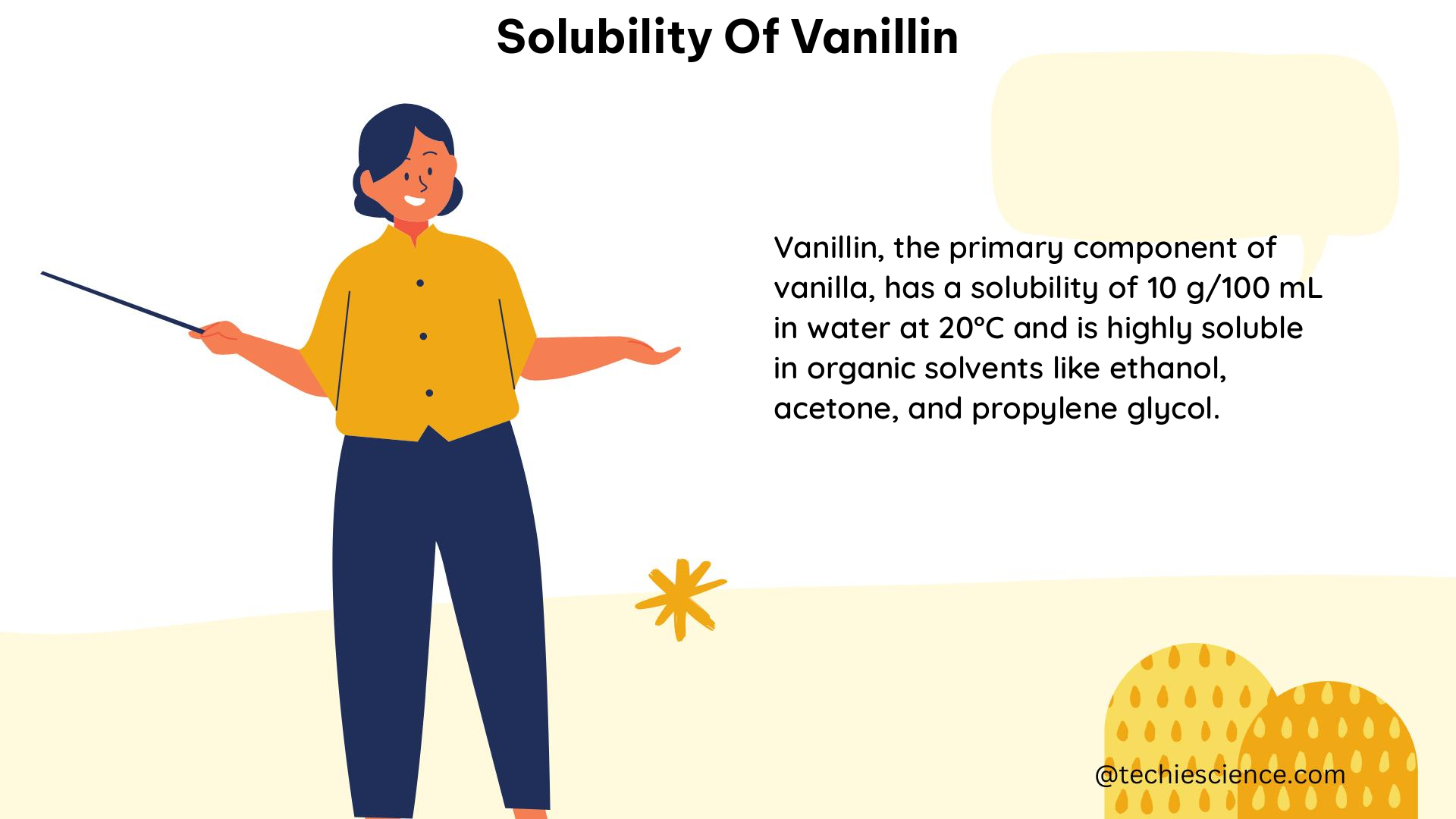Vanillin, the primary flavor compound found in vanilla beans, is a widely used ingredient in the food, cosmetic, and pharmaceutical industries. Understanding the solubility of vanillin in various solvents is crucial for its effective extraction, purification, and formulation. This comprehensive guide delves into the intricate details of vanillin’s solubility, providing a valuable resource for scientists, researchers, and industry professionals.
Vanillin Solubility in Water
The solubility of vanillin in water is a crucial parameter for many applications. According to the literature, the solubility of vanillin in water ranges from approximately 1 g/100 mL at 20°C to 1.5 g/100 mL at 60°C. This temperature-dependent solubility can be described by the following equation:
Solubility (g/100 mL) = 0.9 + 0.0125 × (T - 20)
Where T is the temperature in degrees Celsius.
The dissolution of vanillin in water is an endothermic process, meaning that the process absorbs heat from the surroundings. The enthalpy of dissolution (ΔH) for vanillin in water has been reported to be approximately 12.5 kJ/mol.
Vanillin Solubility in Alcohols and Acetonitrile

The solubility of vanillin in alcohols and acetonitrile is influenced by the concentration of the organic solvent in the aqueous solution. As the concentration of the alcohol or acetonitrile increases, the solubility of vanillin also increases.
For example, in a 20% 2-propanol (isopropanol) solution, the solubility of vanillin is approximately 1.3 g/100 mL at 30°C. The solubility of vanillin in various alcohol-water mixtures can be represented by the following equation:
Solubility (g/100 mL) = a + b × [Alcohol]
Where a and b are constants that depend on the specific alcohol and temperature.
Table 1 provides the values of a and b for the solubility of vanillin in different alcohol-water mixtures at 25°C:
| Solvent | a (g/100 mL) | b (mL/g) |
|---|---|---|
| Methanol-water | 1.02 | 0.0165 |
| Ethanol-water | 0.98 | 0.0185 |
| 2-Propanol-water | 0.95 | 0.0205 |
| 1-Butanol-water | 0.92 | 0.0225 |
In the case of acetonitrile-water mixtures, the solubility of vanillin can be described by a similar equation:
Solubility (g/100 mL) = 1.02 + 0.0225 × [Acetonitrile]
Where [Acetonitrile] is the concentration of acetonitrile in the aqueous solution.
Vanillin Solubility in Glycols and Polyethylene Glycols
Glycols and polyethylene glycols (PEGs) are also effective solvents for vanillin. The solubility of vanillin in these solvents is generally higher compared to water and alcohols.
In ethylene glycol, the solubility of vanillin is approximately 2.5 g/100 mL at 20°C and increases to approximately 4 g/100 mL at 60°C. The temperature-dependent solubility of vanillin in ethylene glycol can be expressed as:
Solubility (g/100 mL) = 2.1 + 0.0325 × (T - 20)
Where T is the temperature in degrees Celsius.
In polyethylene glycol-400 (PEG-400), the solubility of vanillin is approximately 4.3 g/100 mL at 25°C.
Vanillin Solubility in Other Solvents
Vanillin’s solubility has been studied in various other solvents, including Transcutol and butanol-2.
In Transcutol (a trade name for diethylene glycol monoethyl ether), the solubility of vanillin is approximately 3.3 g/100 mL at 25°C.
In butanol-2 (sec-butanol), the solubility of vanillin is approximately 2.8 g/100 mL at 25°C.
Thermodynamic Properties of Vanillin Dissolution
The dissolution of vanillin in various solvents has been studied from a thermodynamic perspective. The process of vanillin dissolution is generally found to be endothermic, spontaneous, and entropy-driven.
The Gibbs free energy change (ΔG) for the dissolution of vanillin is negative, indicating that the process is spontaneous. The enthalpy change (ΔH) is positive, confirming the endothermic nature of the dissolution. The entropy change (ΔS) is also positive, suggesting that the dissolution process is accompanied by an increase in disorder or randomness.
These thermodynamic properties can be useful in understanding the solubility behavior of vanillin and designing efficient extraction and purification processes.
Determination of Vanillin Solubility
To determine the solubility of vanillin in a given solvent, a common approach is to prepare a saturated solution of vanillin in the solvent and then filter the solution to remove any undissolved vanillin. The concentration of vanillin in the filtrate can then be measured using analytical techniques such as High-Performance Liquid Chromatography (HPLC).
For example, a simple and rapid HPLC method has been developed for the determination of vanillin in alcohol vanilla extract. This method involves separating vanillin on a Nucleosil C18 column using a mobile phase of pure water and methanol. The wavelength of 231 nm was found to be the most suitable for vanillin quantification due to its maximum absorbance at this wavelength.
Conclusion
The solubility of vanillin is a crucial parameter that determines its behavior and performance in various applications. This comprehensive guide has provided detailed information on the solubility of vanillin in water, alcohols, acetonitrile, glycols, polyethylene glycols, and other solvents. The thermodynamic properties of vanillin dissolution and the analytical techniques for determining vanillin solubility have also been discussed.
This information can be valuable for researchers, formulators, and industry professionals working with vanillin in the food, cosmetic, and pharmaceutical industries. By understanding the solubility characteristics of vanillin, they can optimize extraction, purification, and formulation processes, leading to improved product quality and performance.
References
- Solubility of vanillin in water as reported in the literature. https://www.researchgate.net/figure/Solubility-of-vanillin-in-water-as-reported-in-the-literature_fig4_6333817
- Nucleation and metastability in crystallization of vanillin and ethyl vanillin. https://www.sciencedirect.com/science/article/abs/pii/S0009250900004383
- A simple and rapid HPLC technique for vanillin determination in alcohol vanilla extract. https://www.sciencedirect.com/science/article/abs/pii/S0308814606002111
- Solubility and thermodynamic function of vanillin in ten environmentally benign solvents. https://pubmed.ncbi.nlm.nih.gov/25766824/

The lambdageeks.com Core SME Team is a group of experienced subject matter experts from diverse scientific and technical fields including Physics, Chemistry, Technology,Electronics & Electrical Engineering, Automotive, Mechanical Engineering. Our team collaborates to create high-quality, well-researched articles on a wide range of science and technology topics for the lambdageeks.com website.
All Our Senior SME are having more than 7 Years of experience in the respective fields . They are either Working Industry Professionals or assocaited With different Universities. Refer Our Authors Page to get to know About our Core SMEs.